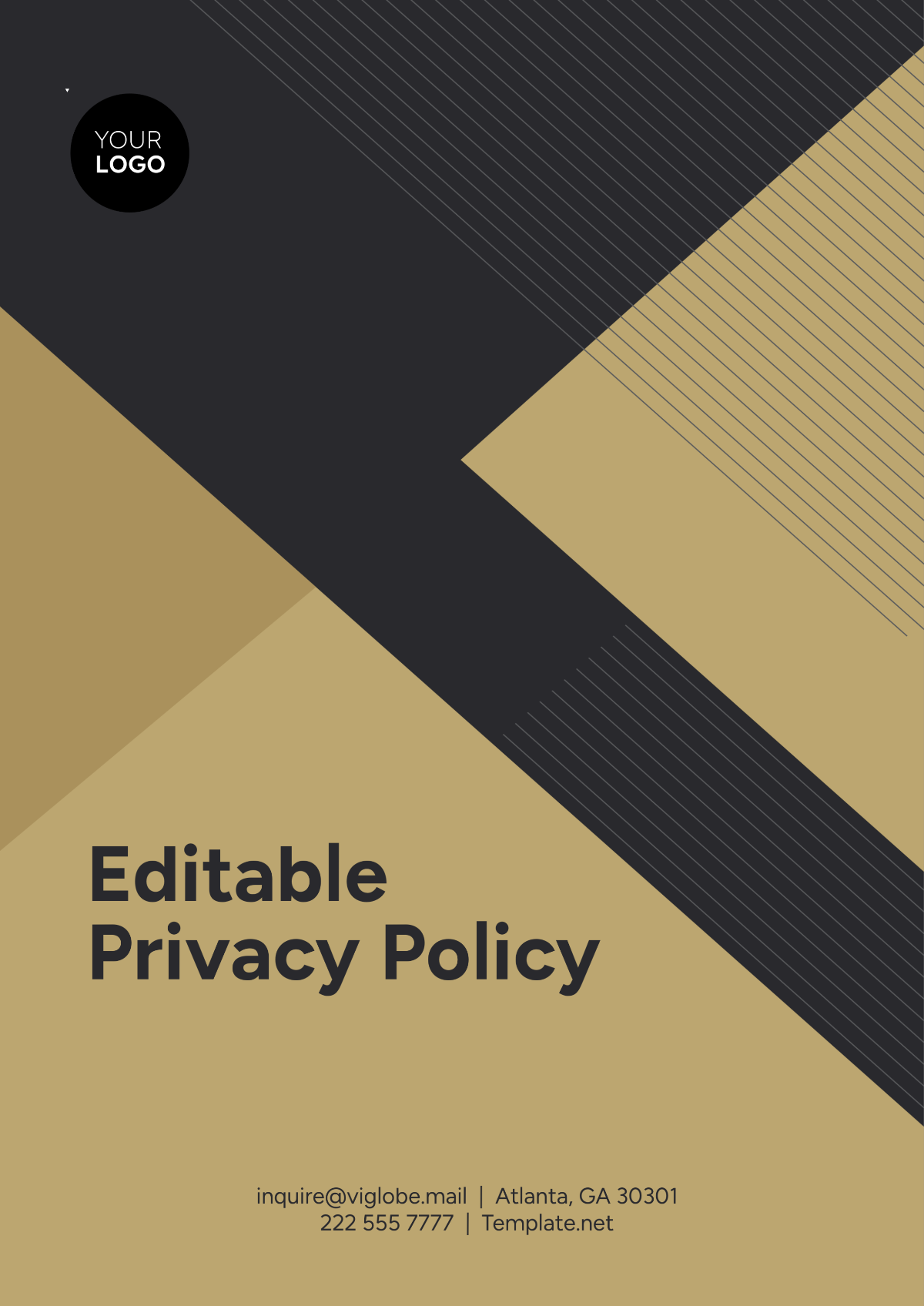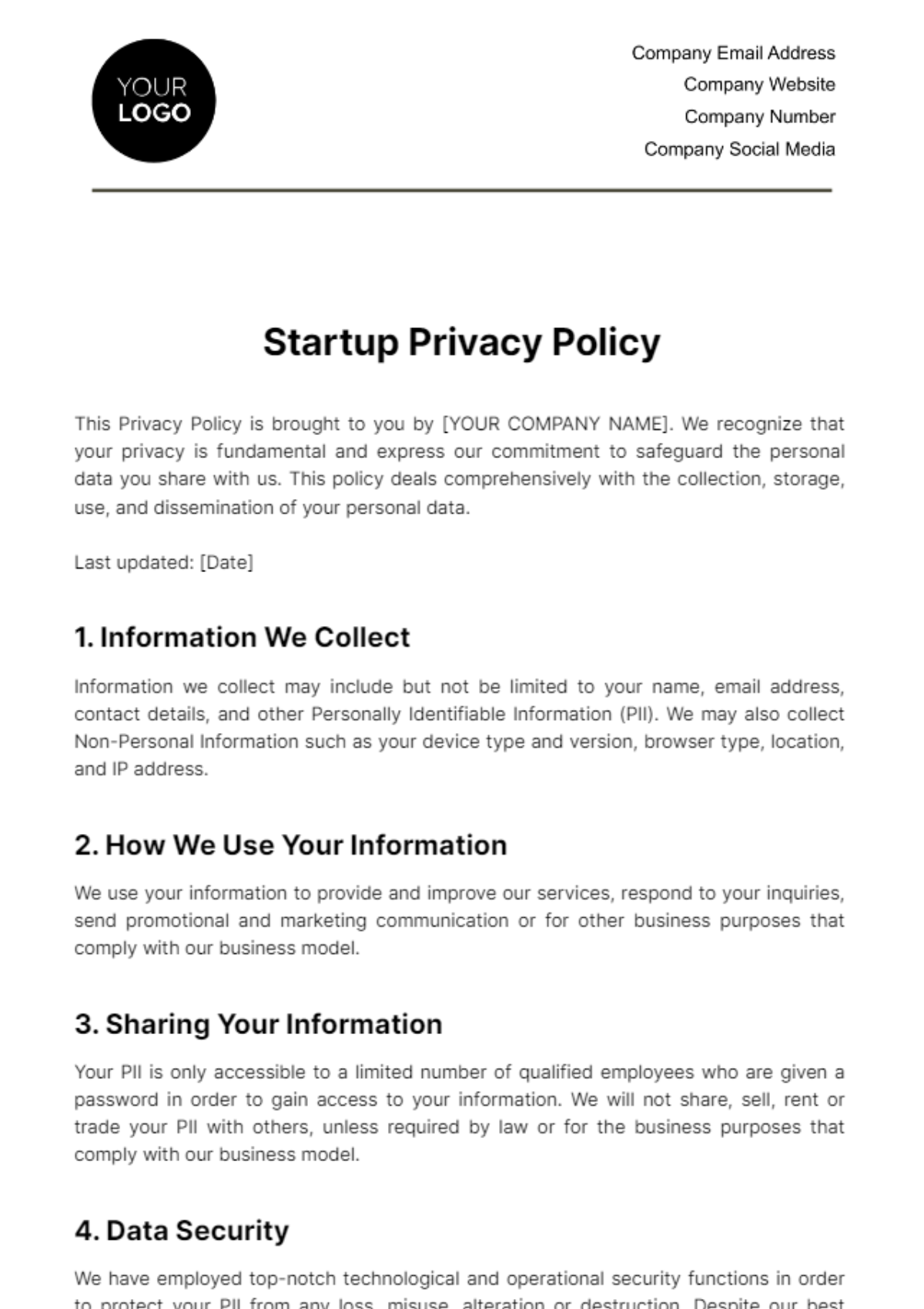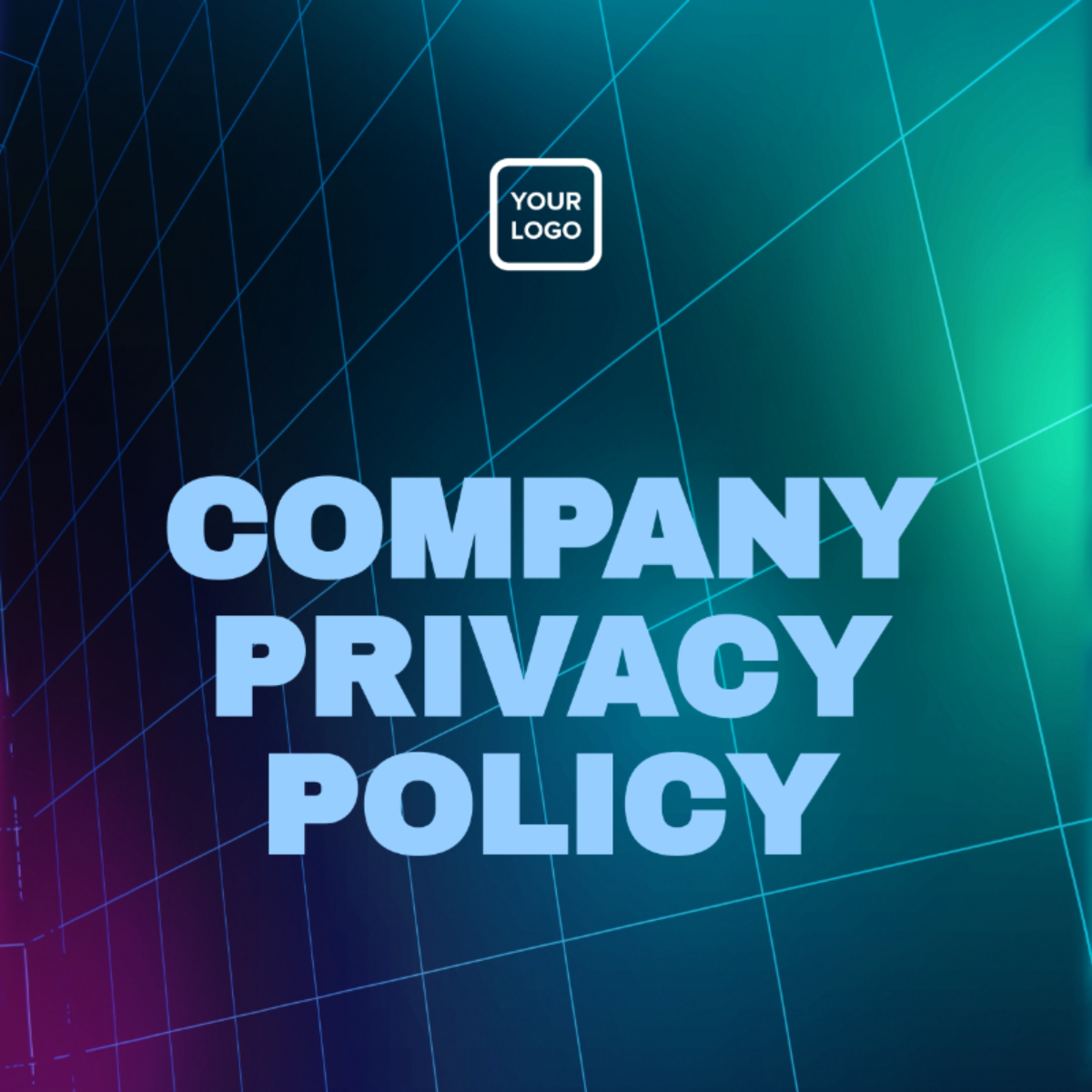I. Introduction
A. Overview
Purpose: This Architecture Privacy Policy is designed to transparently communicate [Your Company Name]'s approach to data privacy and protection. It serves as a guide for users, detailing how their personal information is collected, used, and safeguarded within our architectural services.
Scope: This policy applies to all individuals who interact with [Your Company Name]'s architectural services, including clients, partners, and visitors to our website. It encompasses all aspects of data processing, from collection to deletion.
B. Contact Information
Company Information:
Name: [Your Company Name]
Address: [Your Company Address]
Email: [Your Company Email]
Phone: [Your Company Number]
Website: [Your Company Website]
Data Protection Officer (DPO):
Name: [DPO Name]
Email: [DPO Email]
II. Information Collection
A. Types of Information Collected
Personal Information:
We may collect personal data such as names, email addresses, phone numbers, physical addresses, job titles, and company names to facilitate communication and service delivery.
Technical Information:
When users interact with our architecture platforms, we automatically collect technical data including IP addresses, browser types, operating systems, and device information to enhance user experience and ensure platform compatibility.
Usage Data:
We gather usage data such as pages visited, time spent on pages, clickstream data, and referring and exit pages to analyze user behavior and improve our services accordingly.
B. Methods of Collection
Direct Collection:
Personal information is often provided directly by users through forms, account creation processes, and correspondence with our team.
Automated Collection:
We utilize cookies, web beacons, and server logs to automatically collect technical and usage data, enhancing our understanding of user interactions with our architecture platforms.
C. Third-Party Sources
Partners:
In some instances, we may receive information from partner companies when users interact with integrated services or third-party applications within our architecture platforms.
Public Sources:
We may obtain data from publicly available sources such as social media profiles, ensuring that the information we collect is accurate and up-to-date.
III. Use of Information
A. Purposes of Use
Service Delivery:
We use collected data to provide, operate, and maintain our architectural services, ensuring seamless delivery and user satisfaction.
Communication:
Personal information is used to communicate with users, providing updates, promotional materials, and relevant information about our services.
Improvement of Services:
By analyzing user behavior and preferences, we continually improve our architecture platforms to better meet the needs and expectations of our user base.
Security:
Collected data is monitored and analyzed to enhance the security of our architecture platforms, safeguarding against unauthorized access and malicious activities.
B. Legal Bases for Processing
Consent:
We obtain explicit consent from users for specific processing activities, ensuring transparency and compliance with applicable data protection regulations.
Contract:
Processing of personal data is necessary for the performance of a contract between [Your Company Name] and the user, such as providing requested architectural services.
Legal Obligations:
We process data to comply with legal obligations, including but not limited to regulatory requirements and court orders.
Legitimate Interests:
Certain processing activities are based on our legitimate interests, such as fraud prevention, network security, and business development initiatives.
IV. Information Sharing and Disclosure
A. With Third Parties
Service Providers:
We may share data with trusted third-party service providers who assist us in delivering and improving our architectural services, such as payment processors and hosting services.
Business Partners:
Collaboration with business partners may involve sharing data for joint service offerings, marketing efforts, or other mutually beneficial purposes.
B. Legal Requirements
Compliance:
In accordance with legal obligations, we may disclose information to comply with applicable laws, regulations, or legal processes, ensuring the protection of rights, property, and safety of [Your Company Name], our users, and the public.
Law Enforcement:
We may disclose data in response to lawful requests by public authorities, including but not limited to law enforcement agencies and government agencies, to address security concerns or investigate illegal activities.
V. Data Security
A. Security Measures
Technical Measures:
We implement robust technical measures such as encryption, firewalls, and secure servers to protect data against unauthorized access, alteration, disclosure, or destruction.
Organizational Measures:
Access controls, data minimization strategies, and staff training programs are implemented to ensure that personal data is handled securely and in accordance with our privacy policies and procedures.
B. Incident Response
Breach Notification:
In the event of a data breach, we have established procedures to promptly notify affected users and relevant authorities, mitigating potential risks and minimizing adverse impacts.
Mitigation:
We take immediate action to contain and mitigate the effects of a data breach, conducting thorough investigations, implementing corrective measures, and providing necessary support to affected individuals.
VI. Data Retention
A. Retention Period
Policy:
We retain data only for as long as necessary to fulfill the purposes outlined in this privacy policy, ensuring compliance with legal requirements and user preferences.
Criteria:
Retention periods are determined based on factors such as the nature of the data, legal obligations, and business needs, with regular reviews conducted to assess the ongoing necessity of retaining specific data sets.
B. Deletion Procedures
User Requests:
Users may request the deletion of their data through designated channels, and we promptly process such requests in accordance with applicable data protection regulations.
Automated Deletion:
We have implemented automated processes to regularly review and delete data that is no longer necessary for the purposes for which it was collected, further ensuring compliance with data retention policies and user preferences.
VII. User Rights
A. Access and Correction
Right to Access:
Users have the right to request access to their personal data held by [Your Company Name], and we provide mechanisms for users to obtain such information in a timely manner.
Right to Rectification:
If personal data is inaccurate or incomplete, users have the right to request corrections or updates, and we promptly address such requests to ensure data accuracy and integrity.
B. Data Portability
Request Process:
Users may request their personal data in a structured, commonly used, and machine-readable format, and we facilitate such requests to enable seamless data portability and transferability.
C. Right to Erasure
Request Process:
Users have the right to request the deletion of their personal data under certain circumstances, and we honor such requests by providing mechanisms for users to submit deletion requests and promptly deleting data in accordance with applicable legal requirements and retention policies.
D. Right to Restriction and Objection
Restriction of Processing:
Users may request the restriction of processing their personal data under specific circumstances, such as disputing the accuracy of the data or objecting to the processing of their data for certain purposes.
Objection to Processing:
Users have the right to object to the processing of their personal data for purposes such as direct marketing or legitimate interests pursued by [Your Company Name]. We carefully consider such objections and, where applicable, cease processing the data in question.
VIII. Cookies and Tracking Technologies
A. Types of Cookies
Essential Cookies:
We use essential cookies that are necessary for the operation of our website and the provision of our architectural services. These cookies enable core functionalities such as user authentication and security.
Analytical Cookies:
Analytical cookies allow us to collect information on how users interact with our website and architecture platforms, helping us analyze usage patterns, optimize performance, and improve user experience.
Marketing Cookies:
Marketing cookies are used to track users across websites, enabling us to deliver targeted advertisements and promotional materials based on users' interests and preferences.
B. User Choices
Cookie Settings:
We provide users with options to manage their cookie preferences, allowing them to accept, reject, or customize cookie settings through browser settings or cookie consent banners.
Opt-Out Mechanisms:
Users can opt out of certain tracking technologies by adjusting their browser settings or utilizing opt-out tools provided by third-party service providers, ensuring greater control over their online privacy and preferences.
IX. International Data Transfers
A. Transfer Mechanisms
Standard Contractual Clauses:
Where applicable, we use standard contractual clauses approved by data protection authorities to ensure adequate protection of personal data transferred to countries outside the European Economic Area (EEA) or other jurisdictions with similar data protection standards.
Privacy Shield:
In cases involving data transfers to the United States, we adhere to Privacy Shield frameworks and principles, ensuring compliance with EU data protection requirements.
B. Cross-Border Data Protection
Compliance Measures:
We implement comprehensive measures to safeguard cross-border data transfers, including data encryption, pseudonymization, and adherence to internationally recognized data protection standards and best practices.
X. Children's Privacy
A. Age Restrictions
Policy:
[Your Company Name] does not knowingly collect personal data from children under the age of [13/16], and we take proactive steps to prevent the collection of such data in accordance with applicable laws and regulations.
Parental Consent:
In cases where parental consent is required for the collection of children's data, we provide mechanisms for obtaining verifiable parental consent and ensure that such data is handled with utmost care and confidentiality.
B. Data Handling
Deletion Requests:
We have established procedures for promptly responding to and fulfilling deletion requests submitted by parents or legal guardians on behalf of children, ensuring the protection of children's privacy rights and interests.
XI. Changes to This Policy
A. Policy Updates
Notification:
We notify users of significant changes to this privacy policy through prominent announcements on our website, direct communication channels, or other appropriate means, ensuring that users are informed of any modifications that may affect their privacy rights and obligations.
Effective Date:
The effective date of updated privacy policies is clearly stated to inform users of when the changes take effect, allowing them to review and understand the updated terms and provisions.
B. Review Cycle
Periodic Review:
We conduct regular reviews of this privacy policy to ensure that it remains accurate, comprehensive, and compliant with evolving legal requirements and industry standards. Any necessary updates or revisions are made in a timely manner to reflect changes in our data processing practices or regulatory landscape.
XII. User Inquiries and Complaints
A. Contact Methods
Inquiry Submission:
Users can submit inquiries or complaints regarding data privacy through designated contact channels, such as email, online forms, or dedicated support portals, ensuring accessibility and responsiveness in addressing user concerns.
Resolution Process:
Upon receiving inquiries or complaints, we initiate a transparent and expedient resolution process, investigating the matter thoroughly, providing timely responses, and taking appropriate corrective actions to address user concerns and ensure compliance with our privacy policies and legal obligations.
B. Supervisory Authority
Right to Complain:
Users have the right to lodge a complaint with a supervisory authority or regulatory body if they believe that their data protection rights have been violated or if they are dissatisfied with our handling of their privacy-related concerns. We provide users with information on relevant supervisory authorities and support them in exercising their rights effectively.

















































